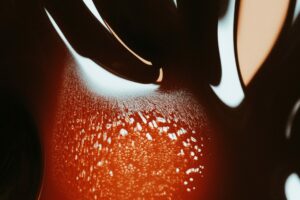Table of Contents
An emulsion is a colloid made up of two or more non-homogeneous liquids, one of which contains the dispersion of the other liquids.
What exactly is emulsion?
Emulsions comprise both continuous and dispersed phases, with the “interface” forming the border between them.
Many phase contacts scatter light travelling through emulsions, giving them a hazy look.
When light is spread in equal proportions, emulsions take on a white colour.
Higher-frequency and low-wavelength light will be scattered in more fractions if the emulsion is dilute, and this form of emulsion will seem blue in colour. The Tyndall effect is another name for this phenomenon.
Types of emulsion:
The features of the dispersed phase and the dispersion medium can be used to classify emulsions.
1) O/W (oil in water):
The oil will be the dispersed phase, and water will be the dispersion medium in this sort of emulsion. Milk is the best example of an o/w emulsion. The fat globules (also known as the dispersed phase) in milk are suspended in water (which acts as the dispersion medium).
2) Water in oil (with or without):
Water will be the dispersed phase, while oil will be the dispersion medium in this case. Water in oil emulsions can be found in margarine (a flavouring, baking, and working spread).
What are Emulsifiers and How Do They Work?
To comprehend this, we must first comprehend the merging process. Coalescing occurs when identical particles in an emulsion join together to produce larger, bulkier particles, causing the dispersed phase and dispersion medium to separate.
Emulsifiers act as a physical barrier between the dispersed phase and the dispersion medium, preventing coalescence. Emulsifiers, like soap, have both a hydrophilic and a hydrophobic end, as we’ve seen. As a result, they can bind to both polar and non-polar materials. Let’s look at sodium stearate as an example.
Methods for Identifying Emulsion Types:
1) Dilution examination
When you add water to an o/w emulsion, it stays stable since water is the dispersion medium, but when you add oil, it destabilises because oil and water are incompatible. Similarly, a w/o emulsion can be diluted with oil and remain stable, but when water is added, it destabilises.
2) Conductivity evaluation
The emulsion is held between two electrodes in this test, and a bulb is connected to the circuit in the manner shown in the diagram. An o/w emulsion will transmit electricity in the same way that water does, while a w/o emulsion will not.
Separation of Emulsions
The different methods by which emulsions can be separated into their constituent liquids include;
1) Heating
2) Centrifuging
3) Freezing, etc
Emulsion’s Applications and Uses
Emulsions are well-known in a variety of scientific domains. It’s employed in the tanning and dyeing industries, as well as the plastics and synthetic rubber manufacturing processes.
Cosmetics, pharmaceuticals, and personal hygiene products are common uses.
Vaccines are delivered using microemulsions, which destroy a variety of microorganisms.
It is primarily employed in the production of polymer dispersions in chemical synthesis.
It’s a firefighting tool.
To kill bacteria, nanoemulsions such as soybean oil are utilised.
Mayonnaise is a water-in-oil emulsion containing egg yolk or sodium stearoyl lactylate.
Emulsification Theories
There are multiple theories that accompany the process of emulsification because it involves several processes and mechanisms (both chemical and physical).
Surface Tension Theory: This theory defines emulsification as a process in which the interfacial tension between two phases is reduced.
The emulsifying agent generates a film over one phase, which leads to the production of globules, according to the repulsion theory. These chemicals oppose each other, allowing them to stay suspended in the dispersion medium due to the repulsive force that exists between them.
Also see: Interference from Thin Films
Emulsion’s Nature
Different emulsifiers may behave differently in the case of a certain emulsion.
Consider the following scenario:
Sodium oleate is needed to make oil-in-water emulsions.
Magnesium and calcium oleates are used to make water-in-oil. The system’s stability worsens when calcium oleate is added to a sodium oleate-stabilized emulsion. At a certain ratio of Na+ to Ca+, the oil-in-water emulsion becomes unstable. The emulsion type is reversed when the concentration of Ca2+ ions is rapidly increased, and the oil-in-water emulsion becomes a water-in-oil emulsion.
Define Emulsion.
“Colloidal solutions in which both the dispersed phase and the dispersion medium are liquids are known as emulsions.”
Q. Describe the characteristics of emulsions.
Ans: Emulsion Properties:
Brownian movement, the Tyndall effect, and electrophoresis are all present in emulsions, just as they are in a colloidal solution.
The globules coagulate when electrolytes containing polyvalent metal ions are added, revealing their negative charge.
The size of the dispersed particles in emulsions is larger than in sols. Its range is from 1000 to 10,000. The size, on the other hand, is smaller than that of suspended particles.
Emulsions can be divided into two liquids by heating, centrifuging, freezing, and other methods. This method is known as demulsification.










